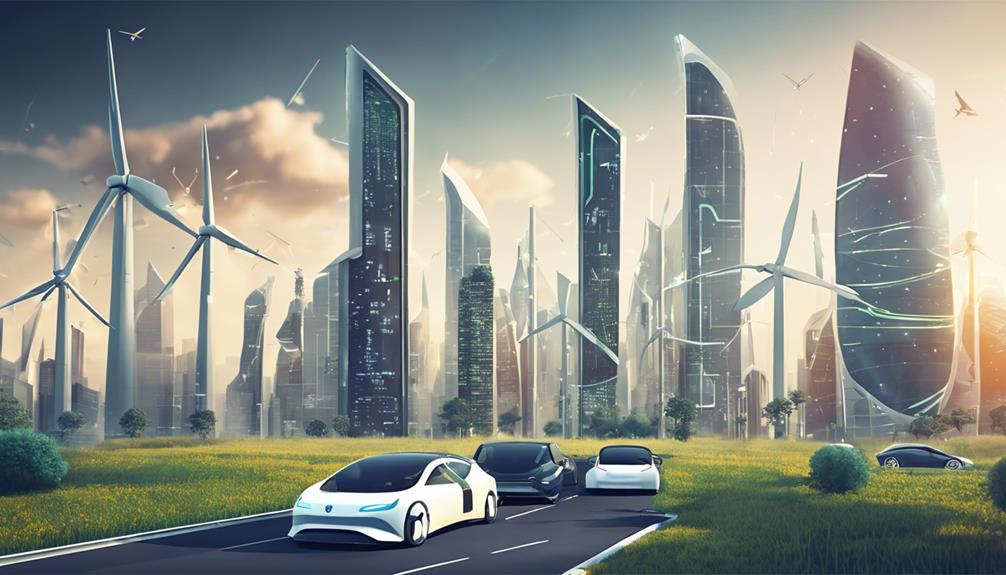In the future, you'll see a shift towards sustainable energy procurement strategies like 100% renewable electricity and Corporate Power Purchase Agreements (CPPAs). Smart metering offers real-time energy data for precise monitoring and efficiency improvements. Self-generation and onsite storage boost energy independence and resilience, aligning with decentralized systems. Benefits include grid independence, peak-time savings, and revenue generation through excess energy sales. Onsite storage solutions and renewable generation are essential for a sustainable energy future, enabling businesses to contribute to net zero targets. Embrace these strategies for a forward-looking approach to energy management.
Key Takeaways
- Transitioning to 100% renewable sources for sustainable energy.
- Implementing smart metering for detailed energy consumption monitoring.
- Increasing self-generation and onsite storage solutions for energy independence.
- Leveraging renewable generation through Corporate Power Purchase Agreements (CPPAs).
- Advancing energy management towards efficiency, resilience, and sustainability.
Sustainable Energy Procurement Strategies
Shifting towards 100% renewable electricity supply is a key component of sustainable energy procurement strategies for businesses seeking to boost their environmental impact and long-term energy resilience. By embracing green procurement methods such as Corporate Power Purchase Agreements (CPPAs), companies can directly source specific renewable power, furthering their energy optimization goals. This approach not only supports the shift towards a more sustainable future but also aids in reducing carbon footprints and promoting cleaner energy alternatives.
In addition to CPPAs, self-generation through Power Purchase Agreements (PPAs) empowers businesses to produce and utilize renewable energy on-site, contributing to a more efficient and environmentally friendly energy mix. Pairing this with the installation of smart meters for detailed energy data allows for better energy management and informed decision-making. Moreover, onsite battery storage plays a significant role in storing excess energy, enhancing sustainability efforts, and ensuring a more stable energy supply for businesses committed to a greener tomorrow.
Smart Metering for Detailed Monitoring
With the rise of smart metering technology, businesses can now access real-time data on energy consumption, enabling precise monitoring for enhanced energy management strategies. Smart meters provide granular details about energy usage, allowing for detailed monitoring of consumption patterns. This real-time analysis is essential for optimizing energy management systems and identifying areas where efficiency improvements can be made.
| Benefits of Smart Metering |
|---|
| Real-time data access |
| Granular energy consumption details |
| Enhanced monitoring capabilities |
Self-Generation and Onsite Storage

Self-generation and onsite storage offer significant advantages for businesses looking to enhance their energy independence. Onsite storage solutions, such as batteries, play an essential role in storing surplus energy for peak efficiency. Embracing these technologies not only reduces carbon footprints but also boosts resilience and aligns with the shift towards decentralized energy systems.
Energy Independence Benefits
Enhancing energy independence through the utilization of onsite generation and storage is key to reducing reliance on traditional grid systems. By embracing self-generation, businesses can achieve grid independence, decreasing their vulnerability to grid failures and peak-time price spikes. The ability to generate electricity on-site not only provides a reliable power source but also opens avenues for peak time savings by avoiding costly grid electricity during high-demand periods.
Furthermore, onsite generation aligns with sustainability goals as it enables the shift towards renewable energy sources, contributing to net zero targets. Pairing self-generation with onsite battery storage enhances resilience by ensuring continuous power supply during outages or times of peak demand. This dual approach not only fosters energy independence but also offers businesses the opportunity to sell excess energy back to the grid, creating additional revenue streams. By diversifying energy sources and leveraging self-generation and storage solutions, companies can secure business continuity while driving cost savings and environmental stewardship.
Onsite Storage Solutions
Implementing onsite storage solutions for energy management involves the integration of self-generation technologies such as solar panels for increased efficiency and sustainability. By utilizing onsite battery storage systems, businesses can store excess energy generated during peak production times for later use, contributing to both energy security and peak shaving. This approach reduces reliance on the grid, enhancing energy resilience and offering greater control over energy supply and demand.
Businesses embracing self-generation and onsite storage solutions not only benefit from reduced energy costs but also have the potential for revenue generation through energy optimization. This shift towards onsite storage solutions marks a significant step in the evolution of energy management practices, allowing for a more sustainable and efficient use of resources while simultaneously decreasing carbon footprint.
As the future of energy management continues to evolve, the adoption of self-generation and onsite storage solutions will play an essential role in optimizing energy usage, enhancing energy security, and promoting a more sustainable approach to energy consumption.
Business Resilience and Revenue Generation
To enhance your business resilience and drive revenue generation, consider implementing energy management strategies that reduce grid reliance and increase self-generation capabilities. By selling excess energy back to the grid and diversifying power sources, you can mitigate risks and tap into new income streams. Embracing net zero targets through energy efficiency and renewable sources not only builds resilience but also opens up cost-saving opportunities.
Resilience Strategies
Business resilience in energy management can be greatly strengthened by strategically reducing consumption during peak times. By implementing energy storage solutions and enhancing grid flexibility, businesses can optimize their energy usage, ensuring continuous operations even in times of high demand or supply disruptions. This proactive approach not only safeguards operations but also minimizes costs by avoiding peak hour tariffs and grid congestion charges.
Moreover, integrating renewable energy sources into the energy management strategy contributes to sustainability goals while enhancing resilience. Diversifying power sources reduces dependency on the grid, mitigating risks associated with grid failures or price fluctuations. By embracing a mix of energy generation options, businesses can adapt to evolving energy landscapes and future-proof their operations against uncertainties.
In essence, resilience strategies in energy management pave the way for a more secure, sustainable, and cost-effective energy future for businesses, offering the freedom to navigate challenges with agility and foresight.
Revenue Generation Tactics
Enhancing business resilience in energy management involves leveraging revenue generation tactics to drive financial stability and sustainability amid a shifting energy landscape. Businesses can tap into revenue streams through strategies like demand response and energy arbitrage. By adjusting energy consumption in response to grid conditions, companies can participate in demand response programs, earning incentives for reducing usage during peak times. Energy arbitrage involves buying electricity when prices are low and selling excess power back to the grid when prices are high, maximizing profit margins.
Moreover, contributing to net zero targets by integrating renewable energy sources and optimizing energy efficiency can create additional revenue opportunities. Diversifying power sources and reducing reliance on the grid not only boosts financial stability but also aligns with sustainable business practices. Implementing these revenue-generating tactics not only secures financial resilience but also positions businesses at the forefront of the evolving energy landscape.
Transition to 100% Renewable Sources

The shift towards a fully renewable energy supply is a pivotal aspect in the evolution of modern energy management systems. Embracing renewable generation is not just a trend but a strategic move towards a sustainable future. Here's a breakdown of key elements driving the energy progression:
| Renewable Generation | Energy Progression |
|---|---|
| Progressing to 100% renewable sources is essential for a sustainable energy future. | Corporate Power Purchase Agreements (CPPAs) play a significant role in enabling businesses to secure specific renewable power sources. |
| Self-generation through Power Purchase Agreements (PPAs) empowers businesses to produce their own renewable energy. | Smart meter installations provide detailed energy data crucial for optimizing energy consumption from renewable sources. |
| Onsite battery storage systems allow businesses to store excess renewable energy for future use, enhancing energy management sustainability. |
As businesses and individuals embrace renewable energy sources, the journey towards a fully sustainable and eco-friendly energy landscape becomes more achievable. By leveraging these strategies, organizations can not only reduce their carbon footprint but also secure a more stable and cost-effective energy future.
Corporate Power Purchase Agreements (CPPAs)
An essential component in securing a stable and sustainable energy future is the utilization of Corporate Power Purchase Agreements (CPPAs). These agreements enable businesses to directly purchase renewable energy from specific generators, fostering renewable energy partnerships and supporting energy efficiency initiatives. By opting for CPPAs, companies can benefit from long-term price stability, reduce their carbon footprint, and align with sustainability goals. The flexibility of CPPAs allows businesses to tailor agreements to meet their unique energy needs while also contributing to the growth of renewable energy sources. This not only helps in securing a stable and cost-effective renewable energy supply over the long term but also drives the shift towards a more sustainable energy future. Embracing CPPAs empowers businesses to actively participate in the renewable energy market, supporting the development of clean energy infrastructure and bolstering environmental sustainability efforts.
Frequently Asked Questions
How Can Energy Management Contribute to Environmental Sustainability?
When it comes to environmental sustainability, energy management plays a pivotal role. By focusing on energy efficiency and conservation, you can make a significant impact. Embracing green technology and innovation is key to reducing consumption and utilizing renewable sources. Imagine a future where your actions contribute to a cleaner, greener world. Through smart meters, battery storage, and self-generation, you have the power to shape a more sustainable tomorrow.
What Are the Potential Risks Associated With Self-Generation and Storage?
When considering self-generation and storage, potential risks include cybersecurity threats that can compromise system integrity. Additionally, battery maintenance is vital to guarantee peak performance and longevity. It's important to address these risks through proactive measures to safeguard your energy systems. By staying vigilant and implementing robust security protocols, you can mitigate these challenges and maintain the reliability of your energy management setup.
How Can Businesses Ensure Uninterrupted Power Supply During Emergencies?
In a world where outages are an ever-looming threat, your business must prioritize emergency preparedness. To guarantee uninterrupted power supply during crises, invest in robust backup solutions. Implementing regular maintenance and testing of generators and batteries is essential. Additionally, establishing a microgrid within your infrastructure can provide resilience. Developing a thorough emergency response plan with power restoration procedures is vital. By utilizing predictive analytics in energy management systems, you can anticipate and mitigate disruptions effectively.
What Are the Challenges in Transitioning to 100% Renewable Sources?
Shifting to 100% renewable sources poses challenges like grid reliability due to the intermittency of renewables. Policy barriers hinder progress, while technology advancements offer solutions. Public acceptance influences the pace of change. Balancing supply and demand with renewables requires innovative forecasting. Upgrading infrastructure for decentralized generation demands investments. Incentivizing renewable adoption through regulatory frameworks is vital. Addressing these obstacles guarantees a successful move to a sustainable energy future.
How Do Corporate Power Purchase Agreements Benefit Companies Economically?
You know, corporate power purchase agreements (CPPAs) are a smart move for companies. They bring about cost savings and risk mitigation. In fact, a recent study found that companies engaging in CPPAs save an average of 10-20% on electricity costs annually. By locking in competitive rates, you gain a market advantage and set yourself apart from the competition. CPPAs help you economically by ensuring stable energy prices and enhancing your financial performance.
